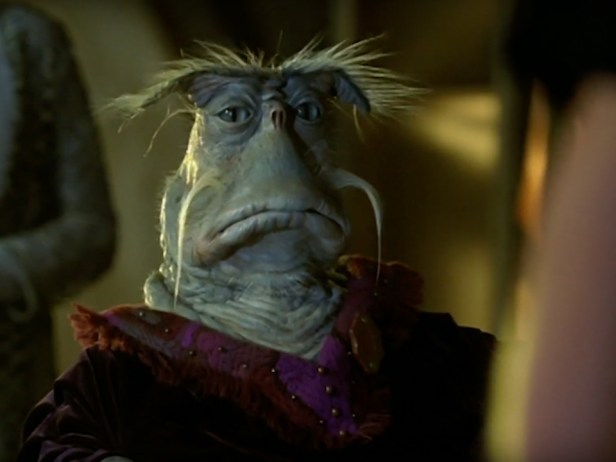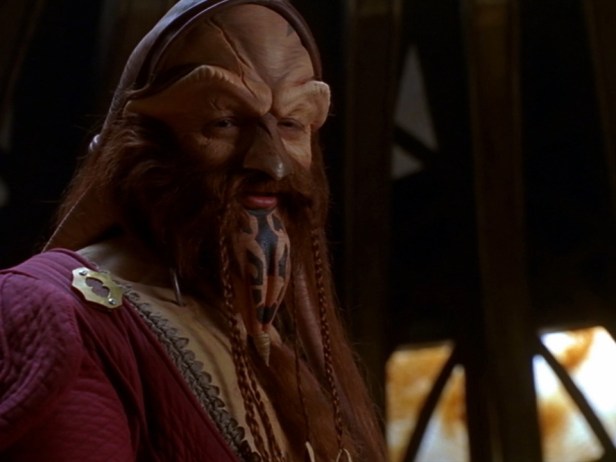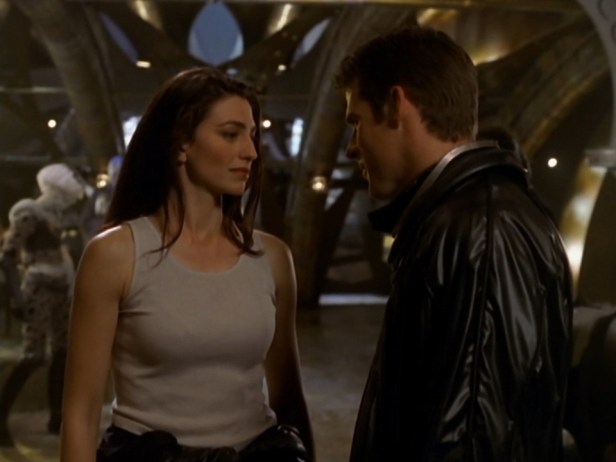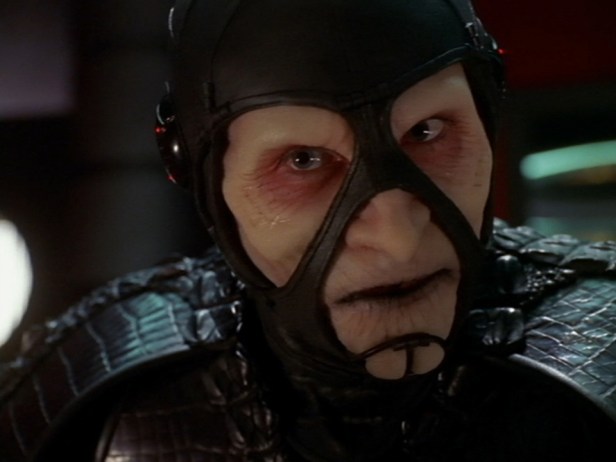Farscape (1999)
Season One
TV sci-fi and fantasy is tribal.
Trekkers are their own thing, as are Whovians, and I’d argue the Whedonites are the big third major grouping, mainly Buffy (1997-2003) boosters but with a large contingent of Browncoats (still, you don’t hear much love for Dollhouse (2009-10) these days, do you?). Battlestar Galactica, in all its forms, has its adherents (currently frothing over a mooted reboot), and maybe X-Files (1993-18) fans are a cultural force that remains unspent. In the current climate, you’ve got The Expanse (2015) fans (Expansionists?), the Berlantiverse kids, and a few other outfits — the fragmented nature of the online narrowcasting means you don’t get these big cultural moments as much anymore, but then again everybody watched Game of Thrones (2011-19), didn’t they?
It gets more interesting at the fringes, with shows like, well, Fringe (2008-13), and there are people who still hold up J. Michael Straczynski’s Babylon 5 (1994-98) as one of the great unsung highlights of genre television. The various other TV offerings never quite got big enough for a decent sized number of fans to accrete around them. Looking back, Max Headroom (1987-88) was groundbreaking stuff, but there’s probably not a dedicated yearly convention in the offing any time soon. More recently, fare like Killjoys (2015-19) and Nightflyers (2018) will similarly not strike the necessary sparks.

But back in ’99, we got Farscape, and Farscape was different. Different enough to stand out from the pack, and to attract that much-needed dedicated fanbase. A fanbase, mind you, vocal enough to see a two-part miniseries get produced to round off the dangling plotlines left over when the actual series got canned in 2003. Don’t let the Browncoats tell you they broke any new ground with Serenity (2005) — The Peacekeeper Wars (2004) got there first.
But we’re getting ahead of ourselves. Let’s be content with a look at the first season for now. Like many opening salvos, especially in the genre space (or is that space genre?), Farscape took a while to really find its feet, and the first season is filled with one-off episodes and tonal and conceptual experiments that, in retrospect, are a bit clumsy. But it did have a hell of central conceit, riffing on the venerable pulp sci-fi of Buck Rogers to drop something akin to an everyman into the middle of a galaxy-sweeping space opera.
Our hero is square-jawed astronaut John Crichton (Ben Browder), whose shuttle flight to test a new theory about wormholes goes awry, and he finds himself instantaneously flung into some far corner of the galaxy. There he hooks up with a mixed bag of alien criminals and renegades who are fleeing the ruthless, humanoid ‘Peacekeepers’ — a kind of jackboot-for-hire paramilitary organization — aboard Moya, a vast living spaceship.

You’d think Crichton, who’s more than a little freaked out by the hostile aliens who greet him on his arrival, would throw in with the Peacekeepers led by Captain Bialar Crais (Lani Tupu) but no dice — the sudden arrival of Crichton’s ship, the Farscape (say the title, win a prize …) resulted in Crais’ brother fatally crashing his own little space fighter, and so our boy is on the run with Moya’s mixed bag of desperadoes, with Crais in pursuit. And that, more or less, is your narrative framework — Buck Rogers in the 25th Century (1979-81) meets Blake’s 7 (1978-81) (an observation made by critic David O’Connell too fitting not to re-use) …
… but with muppets.
Yes, muppets! Created by Rockne S. O’Bannon, who also gifted us with 88’s Alien Nation (yay!) and 94’s SeaQuest DSV ( … fair enough), the series was produced by The Jim Henson Company and Hallmark for the Sci-Fi Channel (and filmed in Australia — dozens of familiar character actors show up). In practice, what that means is a fairly muppety aesthetic that was markedly different from the rank and file space operas concurrently running.
Two characters were just straight-up puppets: deposed regent Rygel XVI (voiced by Jonathan Hardy), a short, arrogant conniver given to farting helium in moments of stress; and Pilot (voiced by Lani Tupu), Moya’s symbiotic helms-alien and crew liaison. Other completely non-human aliens also abounded, which was a pleasant and notable change from the almost entirely humanoid extraterrestrials populating other series (coughstartrekcough).

Even the more human-looking characters were given enough points of difference to make them unique from their genre-mates. Among the Moya mob we got Ka D’Argo (Anthony Simcoe), a hulking Luxan warrior banged up for killing his wife (he didn’t do it), whose distinctive appearance and genuinely unpredictable temper and cultural mores prevented him from being just another re-skinned Klingon (he also had a prehensile tongue like a frog). Meanwhile, plant-lifeform Pa’u Zotoh Zhaan (Virginia Hey) is a blue-skinned empath and spiritual leader, who is also considered a dangerous terrorist by her people. Then there’s chaotic thief Chiana (Gigi Edgley), introduced in episode 15, ‘Durka Returns,’ a kind of manic pixie space rogue who is on the run because she rebels against her species’ devotion to the greater good — an individualistic streak that makes her a rather untrustworthy crewmate.
Crichton is the only human among the regular cast, although there are humanoids — the Peacekeepers are a species called Sebaceans who look completely human and one of them, Aeryn Sun (Claudia Black, arguably the show’s breakout star) joins the Moya against her will — she’s had so much contact with alien lifeforms that the xenophobic Peacekeepers consider her terminally tainted. She’s the most familiar-looking member of the crew to poor Crichton — it’s a shame she hates him right out of the gate.
Indeed, none of the main cast has much reason to like or trust each other, and a lot of the tension in the first season involves wondering just what the various characters will do when presented with a decent shot at their goals and desires. In episode 9, ‘DNA Mad Scientist,’ the crew have remarkably few qualms about lopping off one of Pilot’s arms to give to the titular villain of the week in barter for star maps back to their respective homeworlds — not something you’d likely see Captain Janeway contemplating over on Voyager (well … not for long).

There’s a complexity to Farscape unusual to the genre at the time. If nothing else, the idea that the human-looking characters were the bad guys was novel, but even then, the show steered away from that kind of obviousness. Crais, initially a fairly rote villain, became more complex as the series progressed, eventually becoming an ally to the main crew. Meanwhile, Aeryn’s entire arc involved unlearning the rigid, xenophobic mindset of the Peacekeepers.
It was a truly adventurous space opera that was unafraid to get weird. Indeed, in an interview on Medium, O’Bannon recalls the then-president of the Sci-Fi Network requesting, ‘Please just make it as weird as you possibly can,’ when he and Henson were putting together the pilot (no, not Pilot). And so weird is what we got: a space wizard (‘That Old Black Magic’), astro-navigation by DNA (‘DNA Mad Scientist’), a drugged-out lotus-eater hippie planet (‘Thank God It’s Friday, Again’), carnivorous plant people (‘Bone to be Wild’), dimension-hopping (‘Through the Looking Glass’) and more.
Some of the weirdness worked, and some of it didn’t — season one has a lot of odd standalone episodes that reek of a writers room throwing stuff at the wall and seeing what will stick, taking a lot of Star Trek-esque experimental one-off stabs before beginning to embrace the possibilities of long-form televisual storytelling. Three story strands emerge as the series progresses that will prove to have the most impact going forward.

Firstly, there’s Crichton’s knowledge of wormhole technology. The cause of the hunky scientist-astronaut’s initial accident has huge potential as a weapon, and so Crichton becomes a high-value target for the Peacekeepers and others, extending the ‘on the run’ narrative beyond Crais’ personal grudge.
Then there’s Moya: the living, biological spaceship not only becomes pregnant (and I think that alone is a bit of a first for SFTV) and gives birth to a baby spaceship, Talyn, the little space-mite is an experimental gunship and presents another tantalizing target for the series’ antagonists.
And thirdly, there’s the introduction of that primary antagonist: Scorpius (Wayne Pigram), a Peacekeeper Sebacean/ Scarran hybrid who rolls up in episode 19, ‘Nerve.’ Basically, a sadistic alien BDSM Dom with security clearance, Scorpius makes it his mission in life to unlock wormhole secrets in Crichton’s big old brain and have as much deliciously evil fun along the way. His raunchy fetish aesthetic also adds another dimension of sexuality to what is already an unusually sexy SF show, especially for the time of production — between Zhaan flirting with D’Argo, the staggering UST between Crichton and Aeryn, Chiana teasing anyone within arm’s reach, Rygell playing strange dominance mind games with all and sundry and wistfully recalling his harem, and the actual pregnant spaceship they all live in, it’s a wonder they had time for anything else.

So, in 1999 we got a somewhat pervy puppet show set in space from the creator of Alien Nation (1988) and the people who brought us Fraggle Rock (1983-87) and The Storyteller (1987-89), packed with Australian character actors, with no clear heroes or villains, and a willingness to get — and stay — weird. ‘Cult classic’ doesn’t even begin to describe it. And while Season One struggled a little to get all its pieces in place on the board and to figure out exactly which direction it was going to push in, as Season Two opens Farscape has a real sense of its own identity and purpose — but we’ll get to that next time.
3 / 5 – Good
Reviewed by Travis Johnson
Farscape is produced by The Jim Henson Company
A glorious show which gets nowhere near enough credit or praise. Each episode always seemed to end on a downer and there was a complete Quantum Leap moment of me screaming into a pillow when the last episode first aired, ending with a massive cliffhanger and a ‘To Be Continued’ logo, only for the BBC announcer to pop up and say ‘in spite of what the credits stated, that was in fact the last ever episode of Farscape’. Luckily we did get The Peacekeeper Wars.
Also, I loved the Stargate ‘Crossovers’ which came later